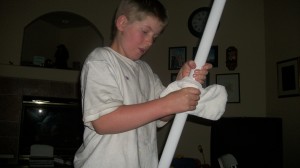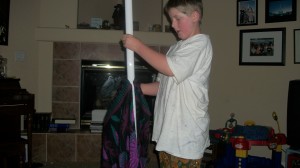This page may contain affiliate links designed to provide a means for sites to earn advertising fees by advertising and linking to other companies. Those fees help keep this site running.
 My son had the option of participating in a science fair for homeschoolers. His first thought was to his science experiment on growing pineapple. However, he realized that he did not have enough time to make the deadline- it’s an project he plans to work on over a longer period of time. So, he chose another project: Fluorescent Light Bulb Experiment that he wrote below:
My son had the option of participating in a science fair for homeschoolers. His first thought was to his science experiment on growing pineapple. However, he realized that he did not have enough time to make the deadline- it’s an project he plans to work on over a longer period of time. So, he chose another project: Fluorescent Light Bulb Experiment that he wrote below:
Purpose: To see which fabrics would produce enough static electricity to light up a fluorescent light bulb when said fabric is rubbed along the tube of the bulb.
Hypothesis: Some fabrics will work while others will not.
- Cotton wash cloth will not work.
- Mom’s 67% acrylic, 33% nylon sweater will work.
- Cotton/polyester blanket will work.
- Polyester blanket will work.
- Microfiber pad will work.
- Flannel pillow case will not work.
- Huggies disposable diaper will work (this was added just for fun at the end of the experiment)
Materials:
- Fluorescent light bulb
- Various fabrics
- 2-3 scientists (one to rub the fabric on the light bulb, one to record the results on paper, one to record with camera or other device)
 Procedure: Do this project at night with all the lights off and record results with a camera or video camera. Rub the different fabrics along the florescent light bulb tube until static electricity is built up to see if the light bulb will turn on or light up.
Procedure: Do this project at night with all the lights off and record results with a camera or video camera. Rub the different fabrics along the florescent light bulb tube until static electricity is built up to see if the light bulb will turn on or light up.
Results:
- The cotton wash cloth did light up the tube, but it was faint and hard to see.
- Mom’s sweater was the brightest.
- The cotton/polyester blanket worked, but it was faint and hard to see.
- Polyester blanket worked well and was nearly as bright as the sweater.
- Microfiber pad worked, but not very bright.
- Huggies diaper worked, but not very bright.
Conclusion: Filming needed to be done with a very sensitive device. We were unable to capture the results on an iphone, a digital camera, a digital camcorder, but was able to capture some hard to see footage on an old JVC compact VHS camcorder. If this experiment were to be done again, all fabrics would be the same size and shape, the light bulb and scientist would be discharged between fabric tests, and we’d have better devices to record the results. This was a fun science fair experiment and is highly recommended for anyone who is interested in static electricity experiments.
We plan to blog about more science fair experiments. In the mean time, I hope to read more of your Science Fair Experiments & ideas.
note: The pictures in this post were taken with the light on to show how we held the fluorescent bulb and fabric to obtain our results. A really slow shutter is needed to capture the light the emanates from the bulb when static builds up.
-
[…] 9 year old son wanted to do an electricity experiment involving Fluorescent Light Bulbs (used in a science fair experiment by my 11 year old) and Power Lines . Near our house, we have three different types of […]
Leave a Comment









It would be interesting to note if the results change due to the season. Static is much more prevalent in the Winter.
Also, did you know that if you hold a Florescent bulb under a power line, the magnetic field will make the bulb glow.
Thank you. Those are some excellent ideas without buying more supplies. I have some really big power lines close enough to my house that it wouldn’t be an inconvenience. I’m not talking ordinary power lines- I’m talking about power lines I can hear humming when I walk underneath. I will have to try your ideas. My kids wanted more electricity experiments.
WONDERFUL Post.thanks for share..more wait ..